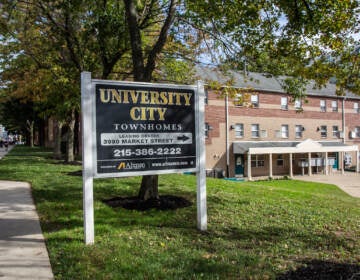The Woodlands, then and now
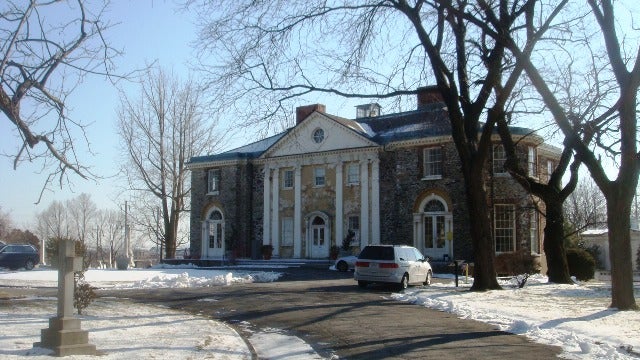
Read a related story
Feb. 17
By Brandon Gollotti
For PlanPhilly
To Philadelphians who have spent time around University City, The Woodlands, at the southeastern tip of West Philadelphia, may stand merely as an eternal home to the deceased. But there is a rich story here about the original 600-acre property that was at the seminal core of American botany. Beyond the varied markers and headstones and unique views of Center City is the striking architecture of America’s earliest intact neoclassical mansion, and an urgent quest for the millions of dollars necessary to restore the exterior of the property and create a master plan that would secure a promising future.
Background
In the middle of the 18th Century, Center City Philadelphia was set off by a distinct street grid but there was little development along the Schuylkill River in what is now West Philadelphia. This area, once known as Blockley Township before the City Consolidation of 1854, was comprised of vast rolling fields.
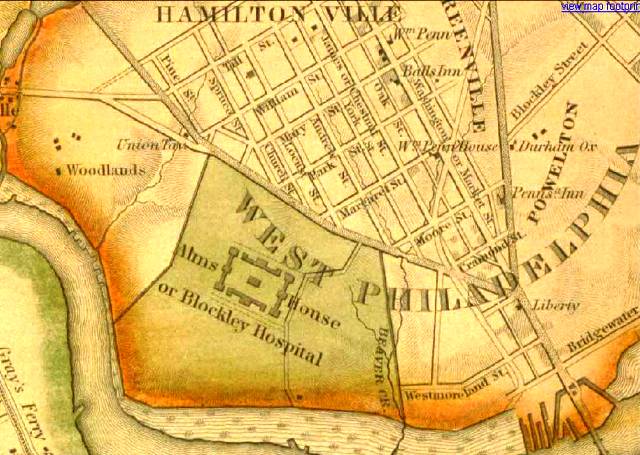
1843 map. Click here for more PhilaGeoHistory Maps.
In 1735, Andrew Hamilton, Speaker of the Pennsylvania House and the man credited with inspiring the term “Philadelphia Lawyer,” purchased land that eventually evolved into The Woodlands. Hamilton’s property stretched from the Schuylkill River up to modern-day Woodland Avenue and from University Avenue to 42nd Street.
In 1767, the undeveloped land had descended to William Hamilton, Andrew Hamilton’s grandson, a student at the College of Philadelphia, now the University of Pennsylvania, in Center City. On his land at the bend of the Schuylkill River near the popular crossing at Grays Ferry, William Hamilton bought additional acreage, which brought the total grounds to 600 acres, and he built a classical villa overlooking the waterway.
After traveling to England and observing grand country estates, Hamilton rebuilt and expanded his mansion in 1786 in the adventurously modern classical taste pioneered by British architects Robert and James Adam. Completed in 1792, the Hamilton Mansion was one of the most of celebrated architectural works of the time because of its grand exterior features, including a two-story Tuscan Portico (the first of its kind in Philadelphia) and one of the most preeminent neoclassical house interiors in the United States.
In July of 1806, in a letter from Thomas Jefferson to William Hamilton, Jefferson commends The Woodlands Estate saying that it is “the only rival which I have known in America to what may be seen in England.”
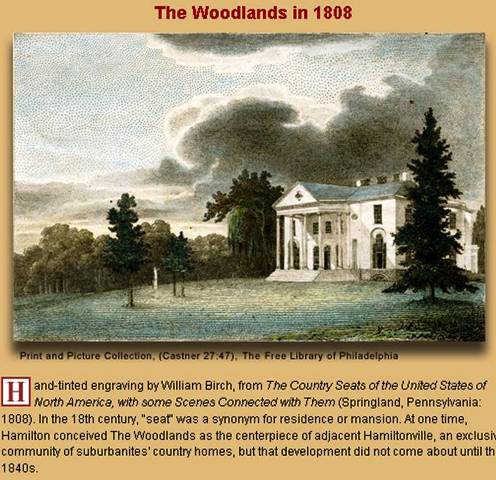
While studying at the College of Philadelphia, William Hamilton developed a love for botany which is shown in the landscape design of his estate. On the grounds, there were over 10,000 different plants and trees, many which were imported from abroad and cultivated in his greenhouse. During his time, Hamilton was one of the premier botanists in the country, collaborating with experts such as John Bartram and Bernard McMahon, in the trading and exchange of seeds and plants. As an authority in the field, Thomas Jefferson asked Hamilton to germinate three lots of seeds collected from the Lewis and Clark expedition. Also, the first Ginkgo tree on American soil grew at The Woodlands.
In 1813, Hamilton died and the land went through a series of family successions. Piece by piece, much of the 600-acre estate would be sold off. In the 1820s, a parcel in the eastern portion was sold to accommodate Philadelphia’s new almshouse and over the decades Philadelphia’s middle and upper classes began to purchase lots north and west of The Woodlands in the area known as Hamiltonville.
Approximate area of the Hamilton Estate on top of modern map of University City.
In 1840, the Woodlands Cemetery Company of Philadelphia purchased The Woodlands mansion and what was left of the surrounding park and gardens with the stated goal that “the beautiful landscape and scenery of that situation [Hamilton’s estate] may be perpetually preserved.” This would rescue the property from Philadelphia’s overwhelming growth in the second half of the 19th century, when the total population would increase from 121,376 in 1850 to over 1,293,697 in 1900. It would also preserve the remaining open land, approximately 92 acres, from being integrated into the West Philadelphia’s “streetcar suburb” and increasingly growing industrial development along the Schuylkill.
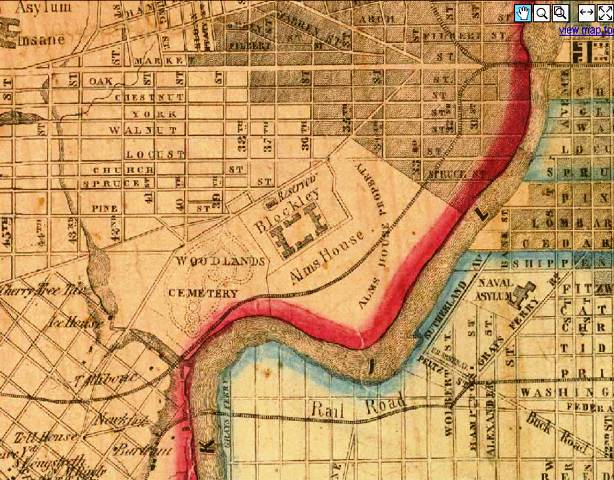
1855 map
The cemetery company transformed the Hamilton’s landscaped estate into a “rural cemetery” with winding paths and lavish monuments. The idea of a rural cemetery at the time was gaining ground, especially after the completion of another Philadelphia cemetery, Laurel Hill Cemetery, upstream along the Schuylkill. During the 19th and 20th Centuries, some of most notable individuals and their families have been interred at The Woodlands. Among them are artist Thomas Eakins (1844-1916), dentist Thomas Evans (1823-1897), financier and Drexel University founder Anthony J. Drexel (1826-1893) and abolitionist Mary Grew (1813-1896).
Read a related story
1942 map
Over the years, The Woodlands has been a subject of scholarly interest and an example of English taste in architecture and landscape gardening. In 1967, the Woodlands became a National Historic Landmark. In 2002, a detailed examination of the mansion was undertaken by the Historic American Buildings Survey (HABS). In 2004, the Historic American Landscapes Survey (HALS) examined the grounds and provided written documentation of the timeline of the land. Both surveys are programs run by the National Park Service.
The Woodlands Today
The Woodlands today is much changed from its horticultural past. Most of the former Hamilton Estate has been developed and the remaining green space is interspersed with tombs and headstones. The former ginkgo trees planted on the estate are reduced down to stumps and the oldest remaining, planted trees on the property are seven English Elms. In 2004, mansion restorers found packets of seeds under the floor boards in the attic. The Academy of Natural Sciences is researching the type and origin of the seeds.
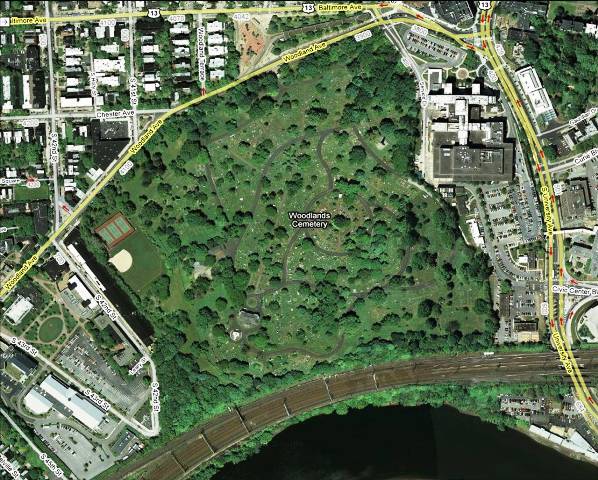
2008 map
The Woodlands is still an active cemetery. Jean Wolf, the Executive Director, says people ask her if the historic cemetery is still in use. Her response, “Yes, all the time.” Currently, there are 30,104 interments and between 20 and 30 new burials a year. Wolf says one of her goals is to show the significance of the cemetery given its city setting and its potential to serve the citizens of Philadelphia.
Publicizing The Woodlands potential and history will help with the fundraising efforts for the much needed restoration and maintenance of the land. In order to increase the public awareness of The Woodlands, Wolf is in the process of applying for a Certificate of Occupancy from Philadelphia. This Certificate would allow public and private events to be hosted at The Woodlands Mansion, after proper building inspections have taken place.
The Woodlands Cemetery Company of Philadelphia and a non-profit charitable organization, The Woodlands Trust for Historic Preservation, are also working together to preserve, protect, and maintain the property, while assisting in efforts with fundraising.
The restoration plans include rehabilitation of the interior and exterior of the Hamilton Mansion. Funding for this restoration is made possible by two grants. One is a $1 million State Redevelopment Assistance Capital Program Grant from the Office of the Budget, which needs to be matched by fund raising through The Woodlands Trust for Historic Preservation and private donations. The second is a Keystone Historical Grant made possible by the Pennsylvania Historic and Museum Commission. However, there are short falls in funding to match the grants, which has temporary stalled plans for the restoration.
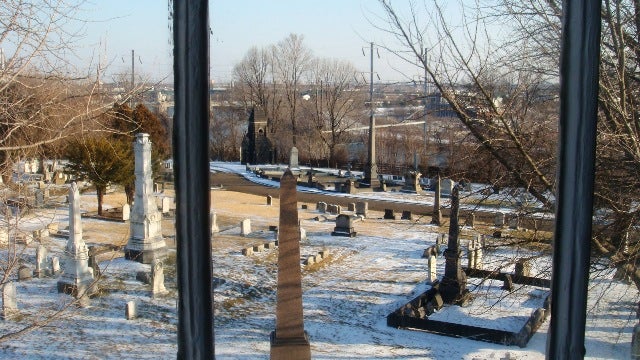
View of the Schuylkill River from the Mansion
One of the major problems The Woodlands faces is the lack of generated revenue, specifically from the cemetery business. Although there are still a couple of dozen burials every year, around half of those take place in family-owned plots, and do not generate additional revenue. Alan Wood, a 10-year board member of The Woodlands Trust for Historic Preservation, says that The Woodlands must start to sell family lots. To do so, The Woodlands must get in contact with families and funeral directors to remind them that there is still cemetery space in the city. “At some point,” Wood says, “families started to move out [of the city] and forgot about the cemetery.” While some Philadelphia cemeteries were fortunate enough to continue to be viable businesses, such as West Laurel Hill, others, like The Woodlands, have struggled.
Harvard Wood III, a board member who joined the trust last fall, brings a new focus to The Woodlands. While in the past, The Woodlands Trust concentrated on the mansion, Wood, who is no relation to Alan, will turn the boards’ attention to The Woodlands Cemetery as a source of income. “Until recently,” Wood says, “we were off the radar [as a cemetery]” to most area funeral directors. Being the owner of a 154-year-old family-owned cemetery memorial business, Wood said he knows what it takes to run a self-supporting cemetery and he has the connections to make it happen. Wood’s goal is to get The Woodlands “back on track as a viable cemetery business.”
The executive director is also pointing the historic cemetery toward a greener future. Wolf believes that people with a new environmental commitment will want expand that train of thought into the how and where they get buried. In addition to installing an environmentally-friendly geo-thermal heating and cooling system for the mansion, the Woodlands is also going to focus on “green” burial in the Woodland grounds near the Southeastern tip of the property. Wolf is also partnering with Schuylkill Banks, a Schuylkill River Development Corporation, in allowing a more permanent running trail along the southern boarder, which interestingly, is where William Hamilton took his guests when they visited his estate.
___________________________________________________
Jean Wolf is the Executive Director of The Woodland and has a background in Historic Preservation. Until 2005, she had her own preservation business and was a historic preservation consultant on many projects in the Philadelphia area, including in the restoration of Christ Church Burial Ground in Old City. Contact her at jwolfwoodlands@verizon.net
___________________________________________________
Alan Wood is part of the Board of Directors for The Woodlands Trust for Historic Preservation. He is the secretary for the Woodlands Trust and serves as the head of the Grounds Committee for The Woodlands. Contact him at awoodpfr@yahoo.com
___________________________________________________
The grounds of The Woodlands are open to the public from dawn to dusk. Tours of the mansion and cemetery, as well as seasonal public programs, are available. For information on these, or volunteer opportunities, call 215.386.2181. For donations, a check can be made out to The Woodlands Trust for Historic Preservation and mailed to:
The Woodlands, 4000 Woodland Ave., Philadelphia, PA 19104-4560
___________________________________________________
Brandon Gollotti joined PennPraxis as an intern in the spring of 2009. He is third year student who is currently attending the University of Pennsylvania pursuing a B.A. in Urban Studies and a minor in History. Before coming to PennPraxis, Gollotti worked on several projects out of PennDesign, including Mapping DuBois and PhilaPlace. Contact him at brandongollotti@gmail.com
WHYY is your source for fact-based, in-depth journalism and information. As a nonprofit organization, we rely on financial support from readers like you. Please give today.




